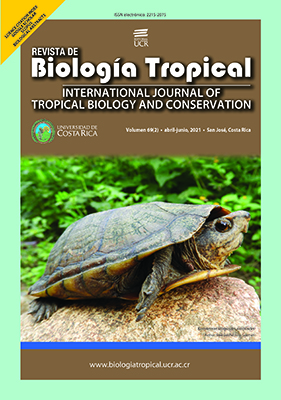Abstract
Introduction: Morphometrics analysis is an efficient and low-cost technique used in studies of sexual dimorphism in turtles. Kinosternon scorpioides scorpioides, scorpion mud turtle, has a wide phenotypic variation, depending on the area of its occurrence. Objective: The objective of this work was to identify the anatomical sexual difference of K. s. scorpioides, adults and hatchlings, through morphometric analysis; and relate the weights of adult animals to environmental factors (temperature and rainfall) in Marajó Island, Brazil. Methods: The sample collection was carried out from March to September 2018, covering both the rainy season (January to July) and the dry season (August to December). For the biometric analysis, 95 adults and 21 hatchlings were used, in which the length and width of the carapace and plastron, height of the shell, and weight were measured (adults only). For the geometric morphometry analysis, 21 adults and 13 hatchlings were used, in which 27 coordinates of anatomical landmarks were inserted in each image of the carapace and 11 in the plastron. Hatchlings were sexed by histology which was enabled by the identification of the ovaries and testicles. Results: The results showed the existence of dimorphism in adults. The plastron and height were higher in females, which had a more rounded carapace than males. This characteristic may be related to the species' sexual strategy, where males impose copulation. Histologically, it was possible to identify the ovaries and testicles in the hatchlings, but there was no anatomical sexual difference, despite the tendency to differentiate in the analysis of carapace PCA. Conclusions: Sexual dimorphism in K. s. scorpioides may play an important role on its reproductive behavior, which is synchronized with environmental events. This fact suggests that the reproductive strategies of this species would be severely affected by changes in the ecosystem.
##plugins.facebook.comentarios##

This work is licensed under a Creative Commons Attribution 4.0 International License.
Copyright (c) 2021 Joilson Silva Da Silva, Brenda Stefany Dos Santos Braga, Juliane Da Silva Costa, Leandro Schlemmer Brasil, Verônica Regina Lobato De Oliveira-Bahia, Relionan Pimentel Leal, José Ribamar Felipe Marques, Diva Anélie De Araújo Guimarães



